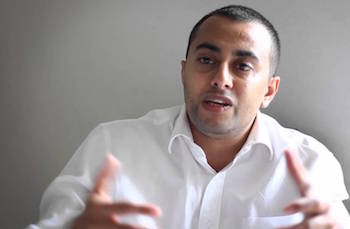If you don’t understand technology or if you don’t get excited about digital innovation and disruption, then you have to be particularly worried about how you navigate a complex future.
Having just returned from an eye-opening working visit to Silicon Valley, I’m more convinced than ever that our leaders have much to do to prepare themselves for success in a disruptive and discontinuous new world.

One of the biggest concerns I have is that digital and technology are no longer the domain of a digital technology officer or the IT division. Rather, because technology is integral to all our lives, the sooner we develop leaders who are digitally savvy the sooner disruption will become the new normal for strategy. And this will better position companies to manage disruption.
The first step every single corporate executive and board should be asking themselves is if the people leading organisations today are digitally enabled. Are they aware of what is happening in the world around them? Do they engage in this world and does it excite them? Or are they stuck in the old ways of doing things? If it’s the latter, then you have a problem.
By ‘digitally engaged’, I’m not necessarily thinking of mad scientists and coding whizzes, but leaders who are curious about technology, who use technology and who are able to see the value it brings.
 Take, for example, a handy App-based paperless parking innovation which you’ll find in operation in Sandton City, Mandela Square, Rivonia Village and Cradlestone Mall, courtesy of a company called Admyt. It’s easier and more efficient than parking in your own garage, and yet most people haven’t cottoned onto this innovation because their mind-set is so focused on traditional paper.
Take, for example, a handy App-based paperless parking innovation which you’ll find in operation in Sandton City, Mandela Square, Rivonia Village and Cradlestone Mall, courtesy of a company called Admyt. It’s easier and more efficient than parking in your own garage, and yet most people haven’t cottoned onto this innovation because their mind-set is so focused on traditional paper.
To use the App you simply input all your car’s details and your credit card information (which is stored using encryption technology). The boom opens automatically when you arrive – thanks to number plate recognition – and again when you leave. You are charged automatically and receive an email receipt.
Tangible technology experience
Or consider that you could outlay roughly R2 500 for a Google Assistant device to help make your house smarter via artificial intelligence (AI). The device allows you to speak to a personal assistant at will, integrates with your calendar and can even help your kids with school projects. It learns your behaviour and patterns over time and immediately gives you a more tangible technology experience.
As an executive you need to intimately understand this kind of disruption and the disintermediation potential it brings to your industry if you are to strategise meaningfully in this new world. But where to start? For me, there are five key areas which have to be understood better.
 The first is robotics. During our time in Silicon Valley we visited the Beam Store at 425 University Avenue, close to Stanford, where you are served by telepresence machines (left) that are manned by warm bodies who can be based anywhere in the world. As you walk into the store, one of the off-site staff members appears on the telepresence robotic machine and gives you full assistance.
The first is robotics. During our time in Silicon Valley we visited the Beam Store at 425 University Avenue, close to Stanford, where you are served by telepresence machines (left) that are manned by warm bodies who can be based anywhere in the world. As you walk into the store, one of the off-site staff members appears on the telepresence robotic machine and gives you full assistance.
There are no human beings physically in the store, which is even opened and close via an App. This use of robotics means that the warm bodies employed could easily be working across multiple sectors, because they are only needed when someone walks into the store. They work on demand and are only paid for the work they do. This opens up all sorts of employment opportunities for students, stay-at-home mum and the unemployed, and has the potential to bring more people into the world of work.
Drones are just as important. We’ve recently seen the Swiss government approving drone delivery of medical samples in certain cities and in Rwanda basic medicines are already being delivered by drones to places where infrastructure simply does not exist. Yes, you can read all about drones to try and understand them, but why not buy a drone and figure it out that way? And, while you’re at it, get your staff to play around too.
Integrating safe artificial intelligence
The third area is AI and machine learning, and this comes down to how we understand the power and safe utilisation of AI in our world. Just think back to that Google Assistant device and how you could integrate that into your life.
The fourth focus is big data and analytics. Many people misunderstand the notion of big data. It’s not about the collection of data but rather about the utilisation of data. It’s about understanding how to translate big data to add value to customers and to gain a deeper understanding of your consumer so you can develop bespoke products and services. This also extends to considerations like how you train your staff by using analytics to determine areas of strength and weakness.
The last point relates to the rise in autonomous technology, so virtual reality and augmentation. The biggest shift here is in the vehicle space with companies like Tesla poised – at the press of a software update button – to turn its Model 3 vehicles into self-driving cars. This is a biggie, shifting the entire sector from the production of machinery to the creation of platforms of engagement.
After all, what could you do in your self-driving car? Have a virtual doctor’s appointment? Speak with your banker? Watch a movie? Automotive companies of tomorrow will be the facilitators of an ecosystem of endless possibilities; they will no longer be manufacturers in the traditional sense.
Scale of disruption
Appreciating the scale of the current rate of disruption is one thing, but we need to bring this understanding back to our home markets in a practical manner, otherwise those fantastical ideas to come out of a place like Silicon Valley are disconnected from reality. In South Africa – and indeed the rest of Africa – we need leaders who are extremely mindful of how to use disruption to impact key sectors like health, entrepreneurship, education or manufacturing. This must take cognisance of contextual factors. Any disruption or development must be contextually relevant and should seek to create more social inclusion, not less.
This means that, locally, we must be sensitive to concerns around technology-induced job losses and try to guard against this by working to re-skill, re-train and re-orientate workers to the new disrupted industries we envisage in the future. Getting this skills shift right requires that we use analytics to determine where jobs might open up and then re-orientate education systems, training and skills around that.
The World Economic Forum says that 65% of young children who are currently starting primary school will go into jobs that, right now, don’t exist. So while we are in the dark as to what they might be doing, we still have to attempt to train them for an alternative future.
Auditing, accounting, medicine and law are all industries currently being disrupted, and yet our education system continues to push students down a sausage machine route. It is a bitter irony that the education system at primary and secondary level is the one sector which has not been disrupted, and yet it continues to feed ‘future leaders’ into the system.
I would argue that while some schools are doing great things, it’s not enough to create a generation of leaders with the right skills and outlook to competently and confidently compete in this new world.
This story was first published in The Media Yearbook 2018. To read the digital magazine, click on the cover image.
Abdullah Verachia CEO of The Strategists and senior faculty at GIBS. He is recognised as a leading dealmaker, strategist and thought leader on company competitiveness and strategy and on frontier and emerging markets.















